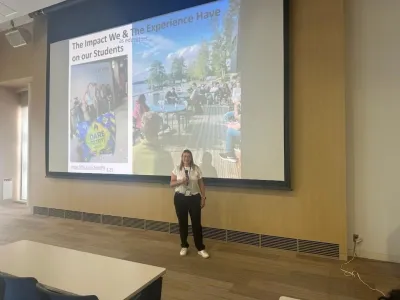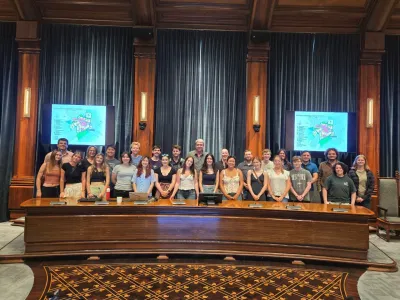As organizations around the world prepare to celebrate GIS Day on Wednesday, November 16th, one Oregon Tech professor is concentrating his talent within Klamath Falls to help develop a model that can be used to benefit community health within the rest of Oregon as part of the Blue Zones initiative. Dr. John Ritter, a Professor of Geomatics at Oregon Tech for more than twenty years, worked in conjunction with Dr. Stephanie Van Dyke, Medical Director of Sky Lakes Wellness Center, and Katherine Pope, Program Director of Sky Lakes Wellness Center, to develop a model to identify health concerns within Klamath Falls using a web mapping system to communicate spatial variation in disease incidence.
At Oregon Tech, the study of Geomatics combines theory, problem-solving and field work to train students for an exciting career that fuses land surveying techniques with computer technology. The University offers two areas of focus within the degree, Surveying or Geographic Information Systems (GIS). GIS involves the creation and use of a "smart map" for addressing geospatial issues pertaining to the disciplines of archeology, urban planning, geomatics, health sciences, management, environmental sciences, and many more.
The GIS mapping project began as a partnership with Sky Lakes Wellness Center as an applied research project to determine if disease incidents could be related to local walkability and/or demographics, and to see if spatial analyses could help in directing resources for intervention efforts. The initial phase of the project was conducted by Brandon Coble, a GIS student in the program, in fulfillment of his senior project. Using the esri ModelBuilder® utility, he constructed a model of the walkability of local streets based on the inputs of 1) local slope; 2) zoning; 3) proximity to public points of interest; 4) population density; 5) road density; 6) housing density; and 7) roadway speed limits. After mapping the spatial distribution of various diseases, Dr. Ritter then used a regression analysis that combined Mr. Coble’s results with area demographics to determine the relationship(s) between the presence of a disease in an area of Klamath Falls with the local walkability, demographics, and presence of other diseases.
Through the analyses, the team identified areas within the community that would greatly benefit from remediation efforts. The Klamath Falls City Council was in the process of creating a comprehensive trail plan for Klamath Falls and the unique analysis that Dr. Ritter was able to present with his analysis identified which areas would benefit most from construction of a downtown bike path. Combined with previous information that had been shared regarding the health benefits associated with more direct access to physical activity opportunities and active commuting, the plan helped the Council to move forward with the approval of an ‘Urban Trails Master Plan’ which could begin to reduce the incidence of obesity and diabetes within the region. As efforts are expanded throughout Klamath County to encourage organizations to become Blue Zone certified, GIS systems can play a key role by itself, but also through integration with Oregon Tech’s Population Health Management program, a new degree offering as well as a relatively new professional field that puts research on the social determinants of health into practice.
The team of Dr. Ritter, Dr. Van Dyke and Ms. Pope are the first people to use GIS in conjunction with Blue Zones initiatives, which outlined a more focused and timely approach on areas that need addressed. As Oregon Tech itself pursues becoming a Blue Zone employer, this system has the possibility of integrating Geomatics and GIS students to work alongside Blue Zones committee members to quickly and accurately diagnose areas to begin work on.









